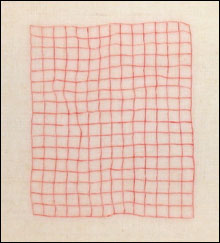
GRAPHING AMBIGUITY: “238 2008,” acrylic
on linen on panel, 7 by 14 inches, by Noa
Warren. |
The experience gap between Greg Parker and Noa Warren makes their joint show at the June Fitzpatrick Gallery at the Maine College of Art all the more exciting. Parker is a veteran Maine painter; Warren, a recent MECA grad, is a studio assistant to Parker. All of the works shown in “New Paintings” are from this year and suggest that the two are less divided by experience than they are united by an unequivocally obsessive dedication to detailed craft, a philosophical approach to ambiguity in the work, and a sculptural eye for the painting as art object.
Each one of Parker’s untitled works is composed of repeatedly applied layers of oil and graphite on panel, built up to an illusory three-dimensionality of abstracted geometries. His technique is so tested it is at times difficult to tell whether his interlocking shapes are stemming from the picture plane or jigsawed from separate panels.
But Parker’s pieces are more about exploration than illusion. His use of color makes the pieces ripple with dimensionality and invites the viewer to approach each work from a multitude of angles. Parker is a master of pigment, able to make entire landscapes with color. In this sense, the viewer becomes the light source, able to alter the scene by casting shadows and moving toward highlights.
This role for the viewer is easiest to experience when the artist chooses to work small. One piece juts out from the wall like a miniature Donald Judd sculpture, but the comparison stops there. Parker’s work is too detailed to dwell in the world of minimalism. Constantly shifting walnut hues are warm and embracing. Surface scratches are possibly a result of a constant polishing process that leaves the edges of the panel beveled, but more likely they are intended to encourage deeper viewing. Every piece is a world unto itself, bearing the unique aura of Parker’s attempts to make that world as perfect as possible.
Although Warren does not plumb the same emotional depths as his employer, he shows a remarkably similar dedication to inventing new visual language through technique. His pieces are both large and small, unorthodox sizes of panel bound in raw linen and fused together to form more traditional dimensions. Warren’s technique involves building up clear acrylic and carefully scoring a grid of incisions that serve as canals for thin lines of color. The inspiration for the grid is graph paper, folded or crumpled up and then spread back down flat. Warren is able to meticulously draw each bend and curve, anticipating the subtle shifts in line at the center that become radical topographical changes at the outer edges. In one particular example, the crinkles and creases that require emulation are so numerous, Warren’s blue lines begin to look like a choppy sea before a storm.
Five paces back, however, reveal a decidedly serene minimalist relation between the basic components of the piece. The grid dissolves and is received by the eye as a total form. The viewer forgets the 8.5-by-11 inspiration and instead sees an irregular shape like no other, quietly coddled in the warmth of the raw linen. Foreground and background oscillate and are accentuated by the easily overlooked divide where the panels are bound together. This divide may be a clue as to what Warren is exploring. The crease ruptures the picture plane and yet disappears from sight when the viewer focuses on other aspects of the composition, much like the straight-lines-turned-topography to which the artist is drawn. This heady subject resides in the same territory as grappling with a physics lecture about curvilinear space or following a philosophical dialogue as it skirts close to a breaking point in logic. Warren’s paintings serve as a reminder that the ground you stand on is not as solid as you think — he highlights this for us by framing it in extraordinarily measured technique.
Comfort with ambiguity draws these artists together; Parker and Warren choose to share this sentiment with their audience like missionaries in a new land. Unlike missionaries, these two believe they don’t have the answer, just an answer. If the viewer can be comfortable with that uncertainty, the enjoyment of these paintings is limitless.
“New Paintings” works by Greg Parker + Noa Warren | at June Fitzpatrick Gallery at MECA, 522 Congress St, Portland | through October 31 | 207.879.5742
Ian Paige can be reached at ianpaige@gmail.com.